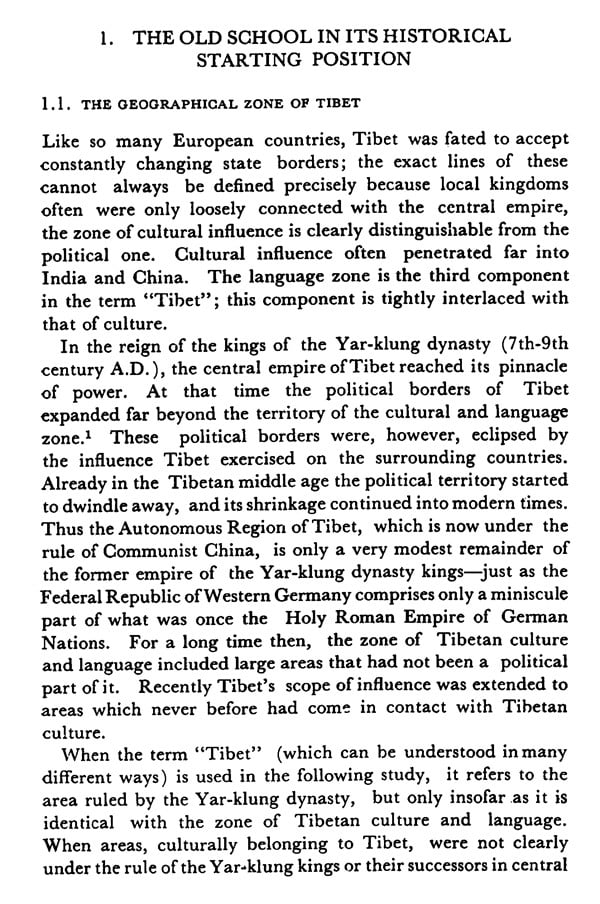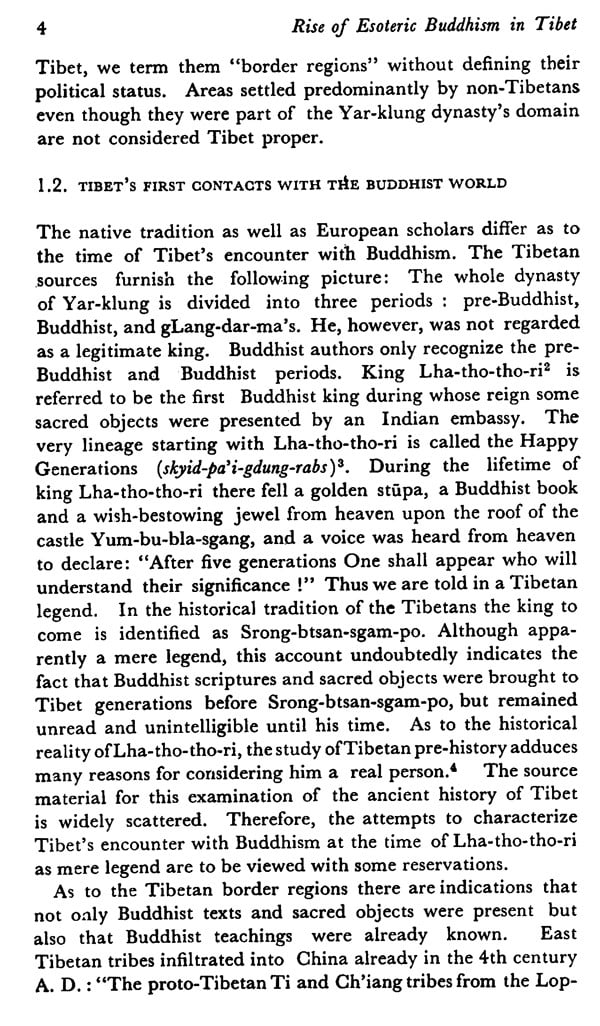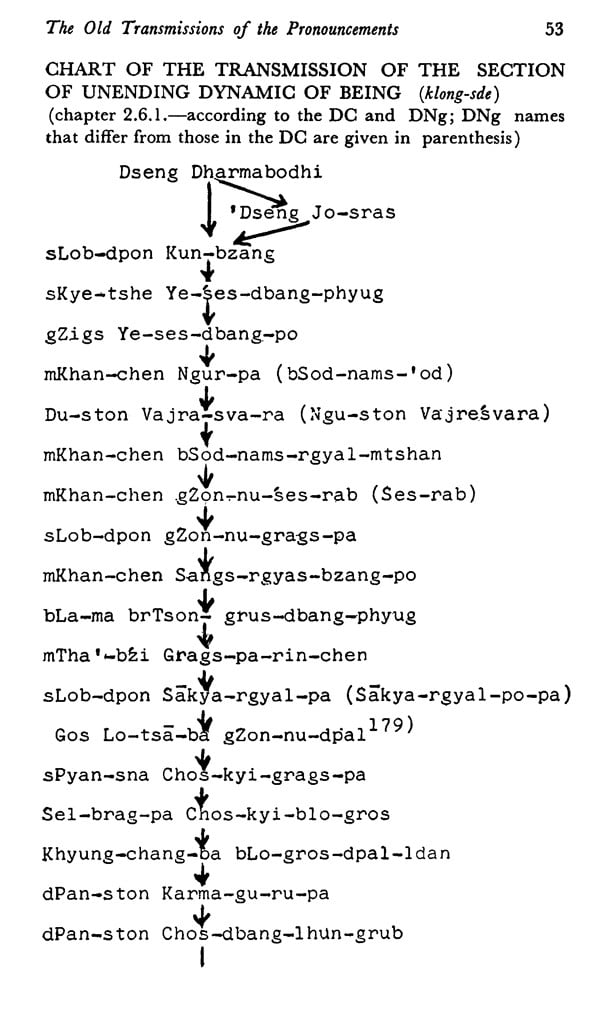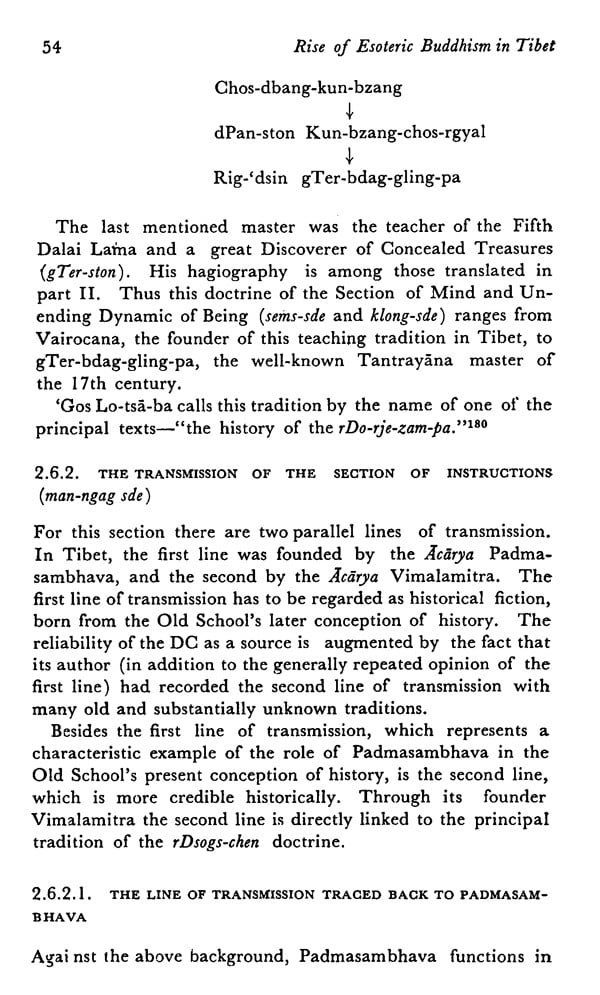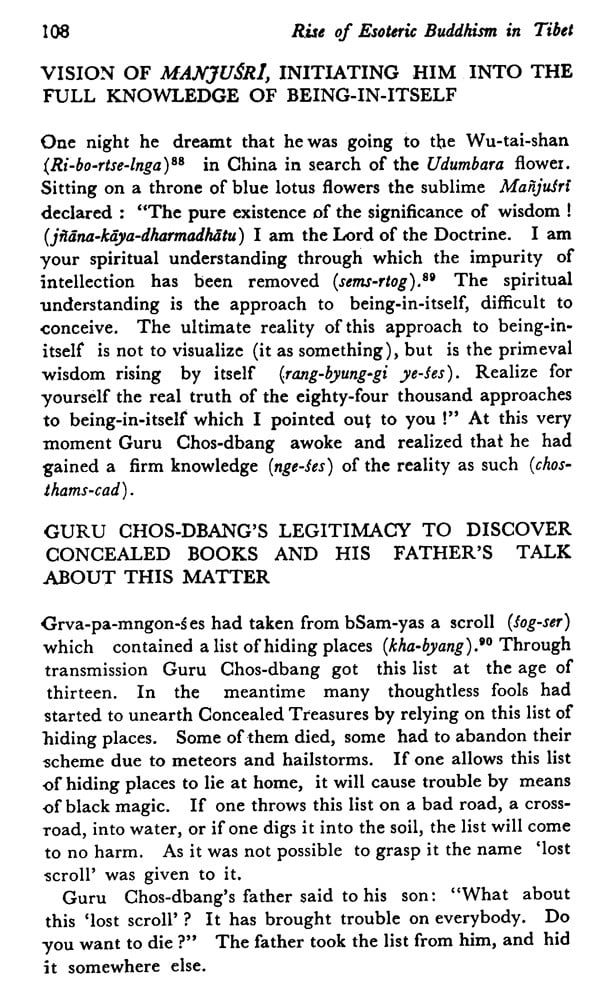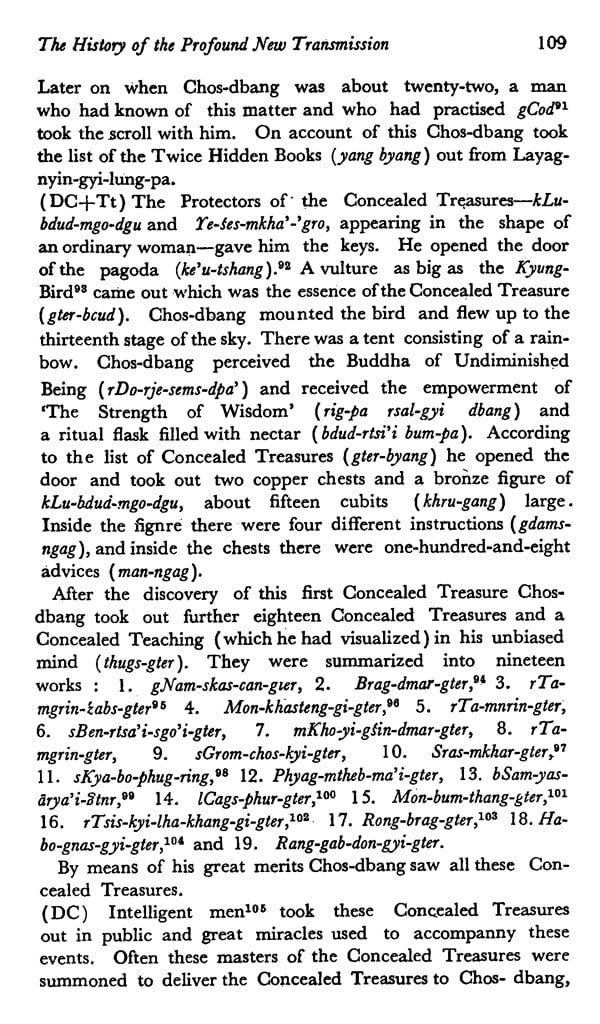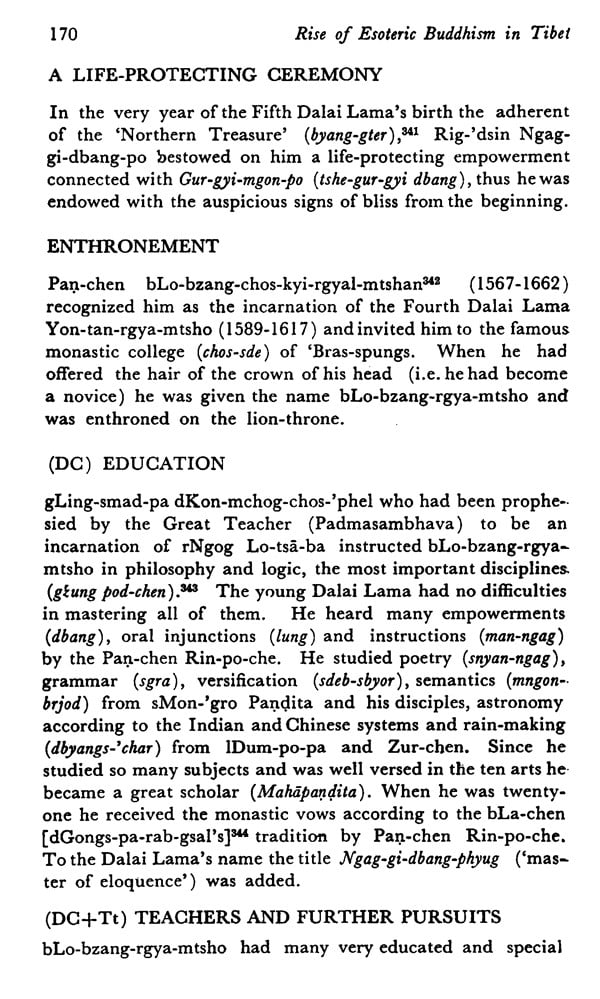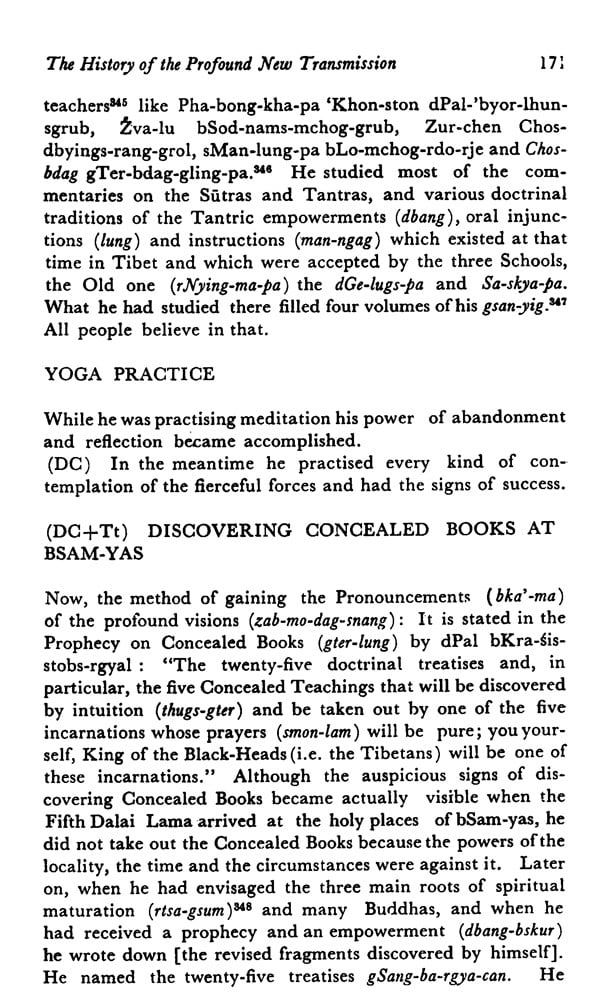
THE RISE OF ESOTERIC BUDDHISM IN TIBET
Book Specification
| Item Code: | IDC284 |
| Author: | EVA M. DARGYAY |
| Publisher: | Motilal Banarsidass Publishers Pvt. Ltd. |
| Language: | English |
| Edition: | 1998 |
| ISBN: | 9788120815797 |
| Pages: | 288 |
| Cover: | Paperback |
| Other Details | 8.5" X 5.5" |
Book Description
In most Asian countries esoteric Buddhism (Tantrayana) declined in the past, while the Tibetans alone preserved the full richness of tantric preserved the full richness of tantric traditions to our times. Thus this study is based on several Tibetan sources never presented in any modern language-some of them were translated, some were given as a summary.
The main concern of this study is to exhibit and analyse the traditions of the Old School of Tibetan Buddhism i.e. the rnying-ma-pa. For the first time there is shown that the history of the Old School goes far beyond the eminent tantric master Padmasambhava; some sources hint at a non-Indian origin of some tantric cycles. The whole tradition of the Old School is divided into two lineages: one of the Pronouncements and the other of the Concealed Treasures. Each lineage is discussed in detail-more than twenty biographies of the famous masters of the Old School are rendered. The author's commentary on these facts and events aims at giving an impression of the spiritual life within the Old School and links the results of this study with the hitherto existing knowledge of esoteric Buddhism. This study exhibits a great deal of so far unknown facts and events that are indispensable for understanding thought and history of Tantric Buddhism in Tibet.
The author, Dr.(Mrs.) Eva Dargyay, is Reader in Tibetology at the University of Munich (West Germany). Being a Cerman specialist in Tibetan and Buddhist studies, she is married to a Tibetan Geshay.
Foreword
The study and appreciation of Tibetan Buddhism is a comparatively recent development. There are many reasons for the fact that an immensely important field in the history of ideas has been neglected for such a long time. The remoteness and inaccessibility of Tibet has tended to shroud what the Tibetans thought, and on what they built their civilization, in mystery, and the myth that Tibetan literature is but a mass of translations from Sanskrit and Middle-Indian vernaculars, perpetuated by academics in the East and the West alike and re-endorsed by a certain segment of the Tibetans themselves that recognizes only Indian sources, prevented people from looking deeper. It shall not be denied that much of Tibetan literature has been translated from Indian sources and that Tibetan Buddhism is deeply indebted to Indian Buddhism, but in the life of a people the important point is not so much the fact that texts were translated but what these translations achieved by stimulating the minds of the people who were eager to absorb and assimilate new ideas. As a matter of fact the indigenous literature that developed in the wake of the translations far exceeds the translations and it is a sad state of affairs that hardly anything of it is known outside Tibet. Moreover Tibetan Buddhism has traits of which no Indian origin is known.
By its geography Tibet was exposed to different influences, if by this term we understand a recasting of ideas rather than a mere superimposition. To the west it was a country of vague definition, known as Shang-shung (zhang-zhung). Its capital to the west of Mount Kailas was until recently a favourite place of pilgrimage for Hindus. The country seems to have had contacts with the neighbouring Indian regions of Kulu and Jalandhar by passes which are still used today. But it also seems to have had close contacts with Kashmir, noted as a great Buddhist country, attracting visitors from as far away as China, especially from the 5th to the 8th centuries. According to Tibetan tradition Shang-shung is the home of the Bon religion which shows both Buddhist and even Iranian influences and which must be credited to have paved the way for the ready acceptance of new ideas. But before Tibet proper emerged as an Asian power and established formal contacts with its neighbours, Nepal and India in the South and China to the East, its main cultural link has been with the Ch'iang tribes on China's north-western borders, who lived within the reach of the trade routes that linked China with India, Iran, and, ultimately, Byzantium and along which all kinds of cultural ideas and artistic motifs found their way into Tibet.
Dr. Eva Dargyay's book deals with the formative period of Tibetan Buddhism and centres round the tradition of the 'Old School' which may be said to have kept the spirit of Buddhism alive, since it was less interested in power politics and mere scholastic debates on problems of philosophy. This school frankly admits that some of its leading figures came from China and that they played an important role in the formation of its way of thought which, for political reasons, had to go 'underground', not only figuratively but quite literally. The period of the so-called 'Religious kings of Tibet' marked a growing emphasis on the Indian contribution which, philosophically speaking, was noted for its interest in epistemology and its almost total rejection of metaphysics. But metaphysics is the life of philosophy; it has lived on in the 'Old School' which had to 'conceal' its texts in face of the changed intellectual and political climate. Later on, when the connection with Chinese Buddhist thought had been mostly forgotten, these texts were 'rediscovered'. Of course, 'reiscovery' implies 're-interpretation' as well as continuity.
Dr. Eva Dargyay thoroughly investigates the many problems connected with the 'Old School'. Thereby she is able to throw new light on the rather enigmatic personality of Padmasambhava.
Students of early Tibetan history and thought will no doubt be grateful to Dr. Eva Dargyay for having undertaken this arduous task of unraveling the traditions and their intricate interrelationships, of one of the most fascinating ways of thinking.
| Foreword by Alex Wayman | v | |
| Foreword by H.V. Guenther | vii | |
| Acknowledgements | ix | |
| List of Abbreviations | xi | |
THE BEGINNINGS OF THE OLD SCHOOL OF TIBETAN BUDDHISM (4th century-10th century) |
||
| 1 | THE OLD SCHOOL IN ITS HISTORICAL STARTING POSITION | |
| 1.1 | The Geographical Zone of Tibet | 3 |
| 1.2 | Tibet's First Contacts with the Buddhist World | 4 |
| 1.3 | The Intellectual Tendencies of Tibetan Buddhism from the 7th to the 9th century | 6 |
| 1.4 | The Consequences for the Old School | 10 |
| 2. | THE OLD TRANSMISSION OF THE PRONOUNCEMENTS | |
| 2.1 | The Foundation in the Transcendental | 12 |
| 2.2 | The Transmission of the Pronouncements through the Intermediators of the Spiritual World | 14 |
| 2.3 | The Principal Tradition of the "Great Perfection" Doctrine | 16 |
| 2.4 | The Transmission of the Mahayoga of the Development | 28 |
| 2.4.1 | The Section of the Tantra Cycles | 28 |
| 2.4.2 | The Section of Meditative Realization | 31 |
| 2.4.3 | The Dissemination of the Teachings of the Eight Pronouncements in Tibet | 33 |
| 2.5 | The Transmission of the Anuyoga of Accomplished Meditation | 38 |
| 2.6 | The Transmission of the Atiyoga of the Great Perfection | 43 |
| 2.6.1 | The Transmission of the Section of Mind and Unending Dynamic of Being | 44 |
| 2.6.2 | The Transmission of the Section of Instructions | 54 |
| 2.6.2.1 | The Line of Transmission traced back to Padmasambhava | 54 |
| 2.6.2.2 | The Line of Transmission traced back to Vimalamitra | 57 |
| 2.7 | Summary | 59 |
| 3. | THE NEW TRNSMISSION OF THE CONCEALED TEACHINGS AND THEIR DISCOVERERS | |
| 3.1 | The Nature of the Concealed Teachings | 62 |
| 3.2 | The Discoverers of Concealed Teachings | 64 |
| 3.3 | The Report of Thu'u-bkvan Rin-po-che bLo-bsang-chos-kyi-nyi-ma concerning the Tradition of the Concealed Teachings | 67 |
| 3.4 | Literary Works of the Tradition of the Pronouncements merge with the Tradition of the Concealed Books | 68 |
| 3.5 | The Earlier and Later Concealed Books | 69 |
| 3.6 | The Newly Concealed Books and the Revival of the Old School | 70 |
| 3.7 | Collection of the Concealed Books | 72 |
| Notes to Part I | 74 | |
THE TRANSMISSION OF THE CONCEALED TEACHINGS AND THEIR PROMULGATORS (11th century-19th century) |
||
| 1 | Introduction | 85 |
| 2 | Hagiography of Sangs-rgyas-bla-ma, the First Discoverer of Concealed Treasures | 92 |
| 3 | Hagiography of Grva-pa-mngon-ses, the Discoverer of the famous Medical Works rGyud-bzi | 94 |
| 4 | Hagiography of Nyang-ral Nyi-ma-'od-zer, the First of the Five Discoverer Kings | 97 |
| 5 | Hagiography of Guru Chos-kyi-dbang-phyug, the Second of the Five Discoverer Kings | 103 |
| 6 | Hagiography of the Female Discoverer Jo-mo-sman-mo, the Consecrated Consort of Guru Chos-dbang | 119 |
| 7 | Hagiography of O-rgyan-gling-pa, the Famous Discoverer of Padmasambhava's Hagiography and the bKa'-thang-sdelnga | 123 |
| 8 | Hagiography of Rig-'dsin-chen-porGod-ldem-can, the Discoverer of the Northern Teachings | 129 |
| 9 | Hagiography of Sangs-rgyas-gling-pa, the Discoverer of the bLa-ma-dgongs-'dus Cycle | 132 |
| 10 | Hagiography of rDo-rje-gling-pa, the Third Discoverer King | 139 |
| 11 | Hagiography of Ratna-gling-pa, the Collector of the rNying-ma-rgyud-'bum | 144 |
| 12 | Hagiography of O-rgyan-padma-gling-pa, the Fourth Discoverer King | 147 |
| 13 | Hagiography of Karma-gling-pa, the Fourth Discoverer King | 147 |
| 14 | Hagiography of Thankg-stong-rgyal-po, the Great Engineer | 153 |
| 15 | Hagiography of mNga'-ris Pan-chen Padma-dbang-rgyal-rdo-rje, a Scholar-Saint and Revivor of Buddhism in Tibet | 156 |
| 16 | Summary of the Hagiography of the Discoverer Lasphro-gling-pa | 160 |
| 17 | Summary of the Hagiography of the Discoverer bDud-dul-rdo-rje | 163 |
| 18 | Hagiography of Lha-btsun Nam-mkha'-'jigs-med, the Great Yogi | 166 |
| 19 | Hagiography of rDo-rje-thog-med-rtsal, the Fifth Dalai Lama | 169 |
| 20 | Hagiography of gTer-bdag-gling-pa, Disciple and later Teacher of the Fifth Dalai Lama | 174 |
| 21 | Summary of the Hagiography of Jigs-med-gling-pa, the Master of the sNying-thig and Editor of the rNying-ma-pa Tantras | 186 |
| 22 | Summary of the Hagiography of mChog-gyur-bde-chen Zig-po-pling-pa, the Famous Disciple of mKhyen-brtse'i-dbang-po and the Master of the Seven Currents of Pronouncements | 190 |
| 23 | Hagiography of 'Jam-dbyangs mKhyen-brtse'i-dbang-po Padma-'od-gsal-mdo-sngags-pling-pa, the Fifth Discoverer King | 197 |
| Notes to Part II | 210 | |
| APPENDIX | ||
| List of the Discoverers of Concealed Treasures | 237 | |
| Chronological Tables | ||
| Masters of the old School | 245 | |
| Political and Religious Events in Tibet | 247 | |
| Chinese Buddhism and its relation to Tibet | 249 | |
| BIBLIOGRAPHY | 250 | |
| INDEX | 257 |
